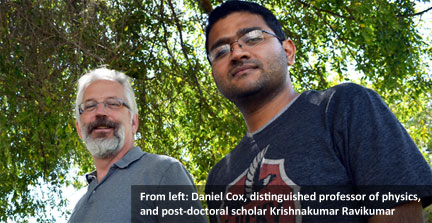UC Davis Researchers Explore Abilities of Self-Assembling Protein
 July 16, 2015
July 16, 2015
By Jocelyn Anderson
One UC Davis research team optimistically gave its latest project the acronym ANSWER and is getting several steps closer to finding one.
By using robust protein architectures to self-assemble devices and materials the researchers hope to point the way to a green manufacturing economy.
The team, which received seed funding through the Research Investments in the Sciences and Engineering (RISE) program in 2012, has been making major progress on the topic, Amyloids for Nanoparticle Synthesis, Wiring, Energy, and Remediation (ANSWER). The interdisciplinary group published two papers this year and founded a startup.
The ANSWER group seeks to harness the unique abilities of amyloid proteins, which share specific structural traits, to self-assemble and modify them slightly so they can grow nanometer scale particles capable of carrying out useful functions when collectively brought together. Materials and devices built this way will require less energy and, being grown primarily in living organisms, non-toxic growth processes.
Already, they have succeeded in making one-dimensional arrays, with two-dimensional deemed possible in the coming months. Such progress means the team could likely use the proteins to template them on other substances.
“We had the idea of a molecular toolkit, where you could assemble them brick by brick to make the structure that you want,” said Daniel Cox, distinguished professor of physics. “And we know we can produce proteins at an industrial level because pharmaceutical companies do it with insulin. With the amyloids, we can get nanoscale precision with these protein bricks.”
For the most recent paper that appeared in the prestigious Nano Letters journal in April, Cox, post-doctoral scholar Krishnakumar Ravikumar and undergraduate student Leonard Heinz studied a modified version of an antifreeze protein, which can block the growth of ice, to see how it bends and twists. They showed that it is quite stiff and mechanically strong, compared to other proteins.
“Those are not just esoteric exercises. If we want to use these for making things, we want to know that they have some structural strength,” said Cox. “And the twist is kind of a nuisance because if we want to lay them out in flat arrays and if they are twisting it gets in the way of order.”
Additionally, Ravikumar added, the research pointed to future possibilities.
“There is a lot of potential, a lot that we can do,” he said. “Once you template these, we can make either conductor or semiconductor materials, which can be used in photovoltaic cells, like solar energy applications.”
If the team can grow gold wires, gold electrodes on the end of each “brick” with semiconducting particles in between, when you shine light on it, it would be a photovoltaic, converting sunlight into electricity. Additional possible applications include filtration of water and energy storage.
“Once we show this material is capable of forming 2-D sheets, we are in for a lot of applications, maybe even strong materials like bulletproof clothing,” said Ravikumar.
The ANSWER team is making the proteins self-assemble at a scale that is normally hard for engineering. They can’t make these materials like we do clothing, but rather must make the proteins self-assemble themselves.
Arising from their work on ANSWER, the team founded a company called Protein Architects, and is currently in the process of applying for patents and exploring government startup funding.
“It gives us more options,” said Cox. “We’d like this to become something viable. If we really want to make a difference, this is one way to do it.”
The ANSWER team was one of 13 supported by the three-year, $10 million RISE program. Designed to launch a new level of interdisciplinary research at the university, each team aims to contribute to solutions to major the problems of the modern era.
“We couldn’t have done this without RISE,” said Cox. “We got enthusiastic buy-in from the team, which includes three theoretical physicists, three experimental chemists, an electrical engineer and a biologist. The RISE support meant we could put this team together.”
Share with:

